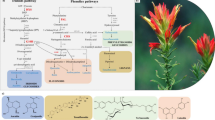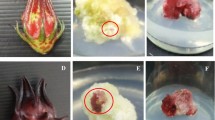Abstract
Chlorogenic acid and its derivatives (CADs) are the bioactive components in Gardenia jasminoides Ellis (GJE) fruits but occur at a low level. In the current paper, four types of calluses were induced from GJE leaf explants, and light yellow-green calluses with a fine appearance and texture were selected for the development of a cell suspension culture to produce CADs. Additionally, cultured cells were elicited by salicylic acid (SA) and methyl jasmonate (MeJA) to increase the CADs yield. Seven CADs compounds were identified via HPLC-TOF-MS/MS, namely, 3-caffeoylquinic acid, 4-caffeoylquinic acid, 5-caffeoylquinic acid, 3,5-dicaffeoylquinic acid, 4,5-dicaffeoylquinic acid, 3,5-dicaffeoyl-4-o-(3-hydroxyl-3-methyl)-glutaroylquinic acid, and malonyl-4,5-o-dicaffeoylquinic acid. This is the first identification of malonyl-4,5-o-dicaffeoylquinic acid from GJE. Both SA and MeJA significantly promoted the CADs yield, but MeJA was more effective than SA. Cells elicited by 200 µM MeJA showed the maximum total CADs content and yield, up to 20.98 ± 1.1 mg g−1 and 232.32 ± 9.1 mg L−1, which were 19.51 times and 14.14 times those of the control, respectively. Furthermore, the total CADs extracted from cells elicited by 200 µM MeJA displayed a much higher antioxidant capacity than that of natural GJE fruits. Our research suggested that a GJE cell culture combined with MeJA elicitation has a promising application in natural CADs production.
Graphical Abstract









Similar content being viewed by others
Abbreviations
- GJE:
-
Gardenia jasminoides Ellis
- CADs:
-
Chlorogenic acid and its derivatives
- SA:
-
Salicylic acid
- MeJA:
-
Methyl jasmonate
- NAA:
-
1-Naphthylacetic acid
- KT:
-
Kinetin
- DFIs:
-
Diagnostic fragment-ions
- 3-CQA:
-
3-caffeoylquinic acid
- 4-CQA:
-
4-caffeoylquinic acid
- 5-CQA:
-
5-caffeoylquinic acid
- 3,5-diCQA:
-
3,5-dicaffeoylquinic acid
- 4,5-diCQA:
-
4,5-dicaffeoylquinic acid
- 3,5-diC(HMG)QA:
-
3,5-dicaffeoyl-4-o-(3-hydroxyl-3-methyl)-glutaroylquinic acid
- M-4,5-diCQA:
-
Malonyl-4,5-o-dicaffeoylquinic acid
References
Ali N, Rashid S, Nafees S, Hasan SK, Shahid A, Majed F, Sultana S (2017) Protective effect of chlorogenic acid against methotrexate induced oxidative stress, inflammation and apoptosis in rat liver: an experimental approach. Chem Biol Interact 272:80–91
Bergonzi MC, Righeschi C, Isacchi B, Bilia AR (2012) Identification and quantification of constituents of Gardenia jasminoides Ellis (Zhizi) by HPLC-DAD-ESI-MS. Food Chem 134:1199–1204
Bonfill M, Mangas S, Moyano E, Cusido RM, Palazón J (2011) Production of centellosides and phytosterols in cell suspension cultures of Centella asiatica. Plant Cell Tiss Organ Cult 104:61–67
Boroduske A, Nakurte I, Tomsone S, Lazdane M, Boroduskis M, Rostoks N (2016) In vitro culture type and elicitation affects secoiridoid and xanthone LC–ESI–TOF MS profile and production in Centaurium erythraea. Plant Cell Tiss Organ Cult 126:1–5
Cai J, Ma Y, Hu P, Zhang Y, Chen J, Li X (2017) Elicitation of furanocoumarins in Changium smyrnioides suspension cells. Plant Cell Tiss Organ Cult 130:1–12
Carmona M, Zalacain A, Sanchez AM, Novella JL, Alonso GL (2006) Crocetin esters, picrocrocin and its related compounds present in Crocus sativus stigmas and Gardenia jasminoides fruits. Tentative identification of seven new compounds by LC-ESI-MS. J Agric Food Chem 54:973–979
Carocho M, Antonio AL, Barros L, Bento A, Botelho ML, Kaluska I, Ferreira IC (2012) Comparative effects of gamma and electron beam irradiation on the antioxidant potential of Portuguese chestnuts (Castanea sativa Mill.). Food Chem Toxicol 50:3452–3455
Chen QC, Youn U, Min BS, Bae K (2008) Pyronane monoterpenoids from the fruit of Gardenia jasminoides. J Nat Prod 71:995–999
Fu X, Yin ZP, Chen JG, Shangguan XC, Wang X, Zhang QF, Peng DY (2015) Production of chlorogenic acid and its derivatives in hairy root cultures of Stevia rebaudiana. J Agric Food Chem 63:262–268
Fujimoto YB, Nishizawa M (1986) Isolation and structural elucidation of a new lipoxygenase inhibitor from gardeniae fructus. Chem Pharm Bull 34:1419–1421
Gouveia SC, Castilho PC (2009) Analysis of phenolic compounds from different morphological parts of Helichrysum devium by liquid chromatography with on-line UV and electrospray ionization mass spectrometric detection. Rapid Commun Mass Spectrom 23:3939–3953
He W, Liu X, Xu H, Gong Y, Yuan F, Gao Y (2010) On-line HPLC-ABTS screening and HPLC-DAD-MS/MS identification of free radical scavengers in Gardenia (Gardenia jasminoides Ellis) fruit extracts. Food Chem 123:521–528
Huang WY, Fu L, Li CY, Xu LP, Zhang LX, Zhang WM (2017) Quercetin, hyperin, and chlorogenic acid improve endothelial function by antioxidant, antiinflammatory, and ACE inhibitory effects. J Food Sci 82:1239–1246
Islam MS, Yoshimoto M, Yamakawa O (2003) Distribution and physiological functions of caffeoylquinic acid derivatives in leaves of sweetpotato genotypes. J Food Sci 68:111–116
Lin P, Yin ZP, Chen JG, Wu S (2017) Effects of different culture conditions on callus growth and chlorogenic acid accumulation in Gardenia jasminoides Ellis. Mod Food Sci Technol 33:181–188
Meier P, Hotti H, Rischer H (2015) Elicitation of furanocoumarins in poison hemlock (Conium maculatum L.) cell culture. Plant Cell Tiss Organ Cult 123:443–453
Mendhulkar VD, Vakil MMA (2013) Elicitation of flavonoids by Salicylic acid and Penicillium expansum in Andrographis paniculata (Burm. f.) Nees. cell culture. Res Biotechnol 4:01–09
Murthy HN, Praveen N (2012) Influence of macro elements and nitrogen source on adventitious root growth and with an olide-A production in Withania somnifera (L.) Dunal. Nat Prod Res 26:466–473
Murthy HN, Lee E-J, Paek K-Y (2014) Production of secondary metabolites from cell and organ cultures: strategies and approaches for biomass improvement and metabolite accumulation. Plant Cell Tiss Organ Cult 118:1–16
Nishizawa M, Izuhara R, Kaneko K, Fujimoto Y (1987) 3-Caffeoyl-4-sinapoylquinic acid, a novel lipoxygenase inhibitor from Gardeniae fructus. Chem Pharm Bull 35:2133
Nopo-Olazabal C, Condori J, Nopo-Olazabal L, Medina-Bolivar F (2014) Differential induction of antioxidant stilbenoids in hairy roots of Vitis rotundifolia treated with methyl jasmonate and hydrogen peroxide. Plant Physiol Biochem 74:50–69
Qin FM, Liu BL, Zhang Y, Zhou GX (2015) A new triterpenoid from the fruits of Gardenia jasminoides var. radicans Makino. Nat Prod Res 29:633–637
Rao SR, Ravishankar GA (2002) Plant cell cultures: chemical factories of secondary metabolites. Biotechnol Adv 20:101–153
Roy A, Ghosh S, Chaudhuri M, Saha P (2008) Effect of different plant hormones on callus induction in Gymnema sylvestris R. Br.(Asclepiadaceae). Afr J Biotechnol 7:2209–2211
Sang H, Park YG, LEE AYH (1991) Suspension culture of Gardenia jasminoides Ellis cell for production of yellow pigment. J Microbiol Biotechnol 1:142–149
Uekusa Y, Sugimoto N, Sato K, Yun YS, Kunugi A, Yamazaki T, Tanamoto K (2007) Neocrocin A: a novel crocetin glycoside with a unique system for binding sugars isolated from gardenia yellow. Chem Pharm Bull 55:1643–1646
Wang J, Liao X, Zhang H, Du J, Chen P (2003) Accumulation of chlorogenic acid in cell suspension cultures of Eucommia ulmoides. Plant Cell Tiss Organ Cult 74:193–195
Wasternack C, Hause B (2013) Jasmonates: biosynthesis, perception, signal transduction and action in plant stress response, growth and development. An update to the 2007 review in Annals of Botany. Ann Bot 111:1021–1058
Xu A, Zhan JC, Huang WD (2016) Combined elicitation of chitosan and ultraviolet C enhanced stilbene production and expression of chitinase and β-1,3-glucanase in Vitis vinifera cell suspension cultures. Plant Cell Tiss Organ Cult 124:105–117
Yan S, Xin W, Luo G, Wang Y, Cheng Y (2006) Chemical fingerprinting of Gardenia jasminoides fruit using direct sample introduction and gas chromatography with mass spectrometry detection. J AOAC Int 89:40–45
Yang L, Peng K, Zhao S, Chen L, Qiu F (2013) Monoterpenoids from the fruit of Gardenia jasminoides Ellis (Rubiaceae). Biochem Syst Ecol 50:435–437
Yin Z, Shangguan X, Chen J, Zhao Q, Li D (2013) Growth and triterpenic acid accumulation of Cyclocarya paliurus cell suspension cultures. Biotechnol Bioproc Eng 18:606–614
Zhang Y, Shi P, Qu H, Cheng Y (2007) Characterization of phenolic compounds in Erigeron breviscapus by liquid chromatography coupled to electrospray ionization mass spectrometry. Rapid Commun Mass Spectrom 21:2971–2984
Zhang JY, Zhang Q, Li N, Wang ZJ, Lu JQ, Qiao YJ (2013) Diagnostic fragment-ion-based and extension strategy coupled to DFIs intensity analysis for identification of chlorogenic acids isomers in Flos Lonicerae Japonicae by HPLC-ESI-MS(n). Talanta 104:1–9
Zhang X, Dong J, Liu H, Wang J, Qi Y, Liang Z (2016) Transcriptome sequencing in response to salicylic acid in salvia miltiorrhiza. PLoS ONE 11:e0147849
Zhang XX, Shi QQ, Ji D, Niu LX, Zhang YL (2017) Determination of the phenolic content, profile, and antioxidant activity of seeds from nine tree peony (Paeonia section Moutan DC.) species native to China. Food Res Int 97:141–148
Zhu H et al (2014) Simultaneous determination of two iridoid glycosides, two anthraquinones and four flavonoid glycosides of Zhi-Zi-Da-Huang decoction in rat plasma by UFLC-MS/MS: application to a comparative pharmacokinetic study in normal and cholestatic liver injury rats. J Chromatogr B 960:116–125
Zou R, You Y, Chen Z, Kai HU, Ran L (2016) Effects of drying methods on polyphenol compounds and antioxidant activities of Lonicera japonica flower. Food Sci 37:78–83
Acknowledgements
The authors are grateful for the financial support of research projects from the Natural Science Foundation of PR China (No. 31260368; No. 31460436) and Food and Drug Administration of Jiangxi Province of China (No. 2015yp17). The authors also acknowledge the HPLC-TOF-MS/MS technical assistance of Analysis and Determination Center, University of Nanchang, Jiangxi, China.
Author information
Authors and Affiliations
Contributions
ZPY and XCS conceived the idea and designed the experiments. ZBL and JGC performed the experiments. ZBL, TL, and PL analyzed the data. All the authors contributed to writing and editing of the manuscript.
Corresponding author
Ethics declarations
Conflict of interest
The authors declare that they have no conflict of interest.
Additional information
Communicated by Sergio J. Ochatt.
Rights and permissions
About this article
Cite this article
Liu, ZB., Chen, JG., Yin, ZP. et al. Methyl jasmonate and salicylic acid elicitation increase content and yield of chlorogenic acid and its derivatives in Gardenia jasminoides cell suspension cultures. Plant Cell Tiss Organ Cult 134, 79–93 (2018). https://doi.org/10.1007/s11240-018-1401-1
Received:
Accepted:
Published:
Issue Date:
DOI: https://doi.org/10.1007/s11240-018-1401-1




